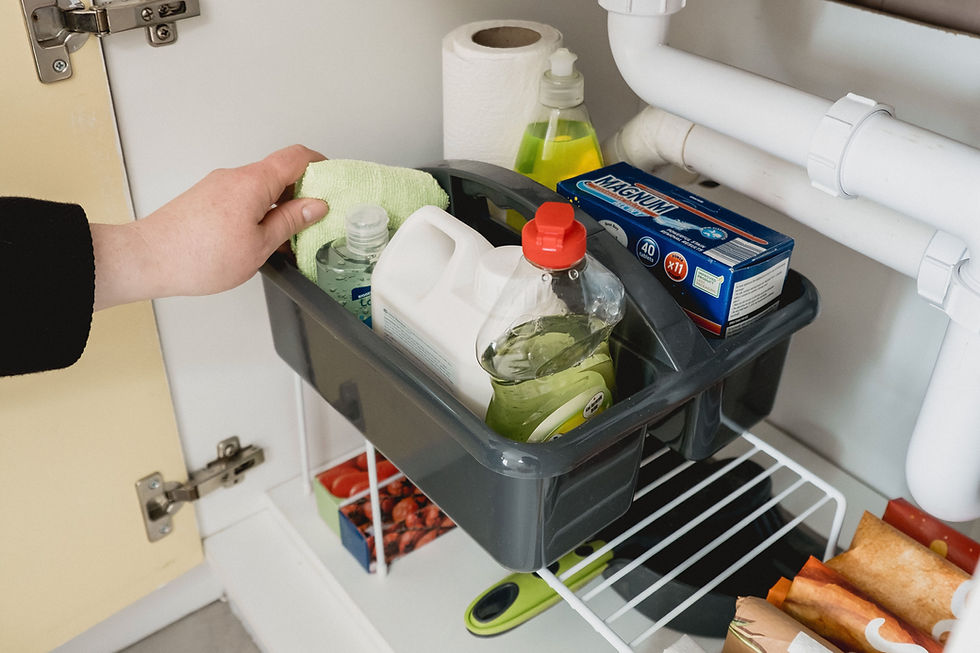Top Tips for Kitchen Organisation
- Rosie Barron
- Apr 16, 2021
- 3 min read
Updated: Dec 8, 2022
We are on our third week in the Kitchen and this week we are going to focus on the things that we use to eat and drink with.
As usual, the trick is to Gather by Category. For example, cutlery, serving utensils, serving dishes, crockery, glasses, mugs and so on. Also, as usual, there is no predefined or set number of items for you to keep, you must keep the right number of items for you and your situation. Make sure that you Handle Each Item to check if it Sparks Joy. Some items will be easy to make decisions on; there will be some stuff that you love and some stuff that you will wonder why you even had it in your home. For other things though, it might be a bit harder for you to decide, so here are a couple of questions that you might find useful.
“How many of these do I use on a regular basis?” and “Could I borrow this item if I needed it?”

One thing I would encourage you to do is to Use the Nice Stuff Every Day. Use the beautiful plates and delightful glasses, don’t leave them to gather dust in the cupboard. Yes, over time some will get broken, but how much worse for them to never leave the cupboard, or only on special occasions? We use ours on a daily basis.
When you have finished with deciding what you want to keep, now is the time to look at overall kitchen storage. Every kitchen is slightly different in layout of course, so without seeing your personal space, it can be hard to make recommendations, but I shall try and do some general ones.
As far as possible, Keep your Kitchen Surfaces Clear of clutter. The clearer they are, the easier they are to keep clean, and the easier they are to keep clean, the nicer experience cooking is. Marie Kondo recommends putting items like the toaster away after each use but, whilst I do keep the surfaces pretty clear, I can’t be bothered with that. The toaster is used frequently and the kettle barely has a chance to cool down before I make my next cup.

Heavy items should be stored as close to the bottom as they can be. Not only will this prevent them from breaking shelves, but it will save your back as you it is easier to lift them from there. Lighter items, including glassware can be stored higher up. It looks nicer as well as being easier.

Keep Children's items within their Reach
If you have children and they are regularly accessing their own snacks, or laying the table, make sure that those things are within easy reach for them. In my kitchen, I have a box of snacks that the kids are allowed to help themselves to at certain times. It’s not actually terribly convenient for me as it’s a little low down, but it’s great for them to get to. They have a “lunch” box in the fridge where the refrigerated supplies for their lunches live. Easy for them to access. Similarly, the plates and glasses that they use on a daily basis are stored lower than the glasses that my husband and I use.

I store the mugs and hot drink supplies near the kettle and the food near the prep space. Crockery is mainly kept in the dresser which is alongside the table, spices in a drawer right next to the cooker. Regularly used stuff is kept closer to the front of the cupboard and within easier reach than stuff that is used less frequently.
For the entire series on decluttering and organising your home, check out this blog:
For a set of Guides on various subjects, check out this page: https://www.thetidycoo.com/thetidycooguideto
For my Book, go here: https://www.thetidycoo.com/product-page/easy-life-from-chaos-to-calm-with-minimal-effort
Interested in more? Check out 12 Weeks To Tidy: https://www.thetidycoo.com/12-weeks-to-tidy

































Comments